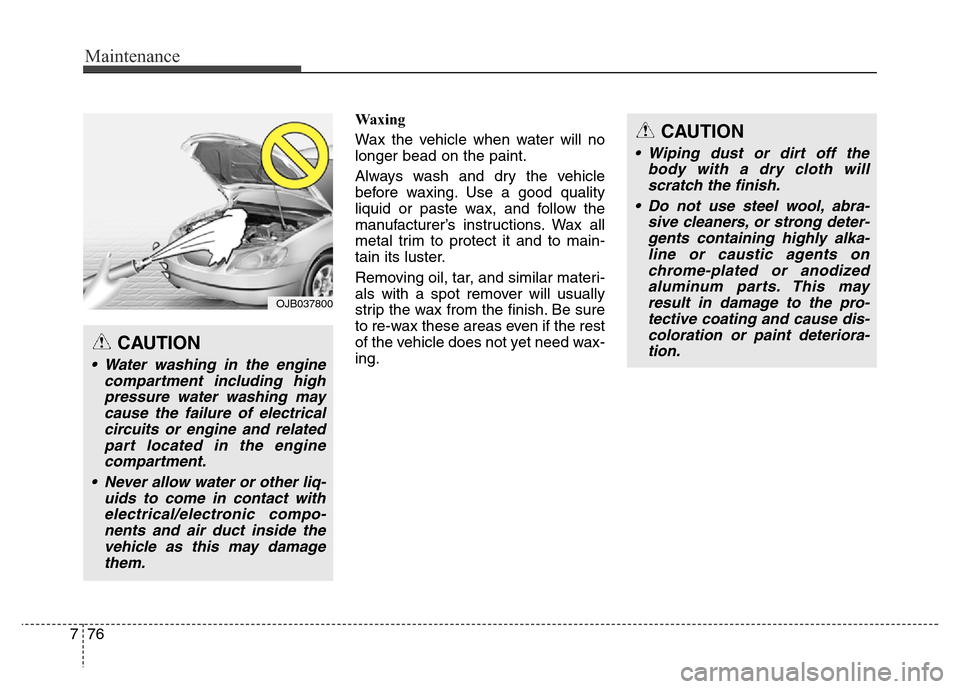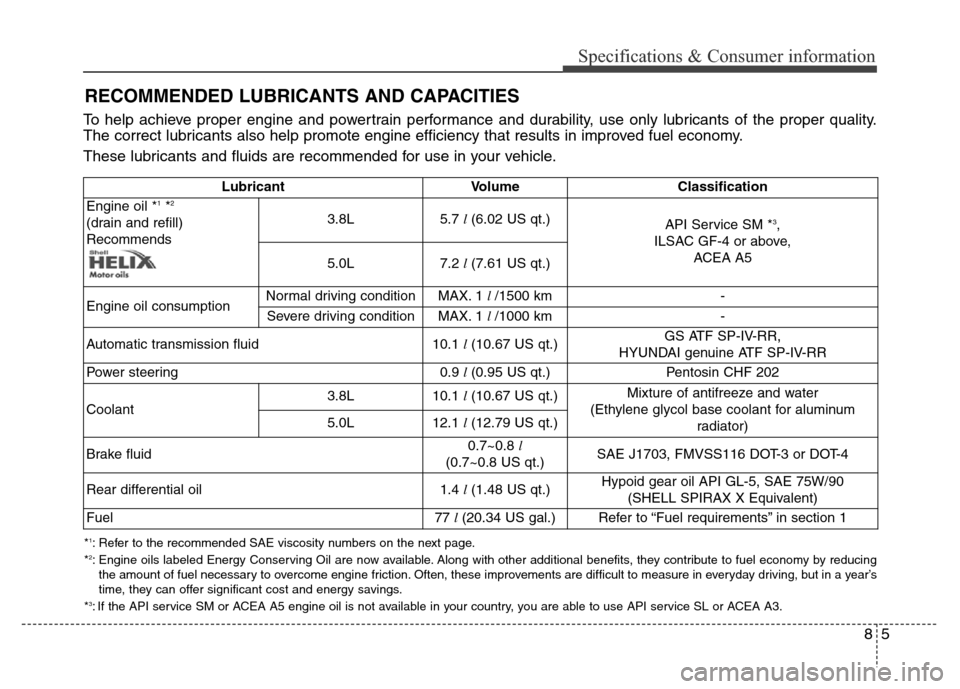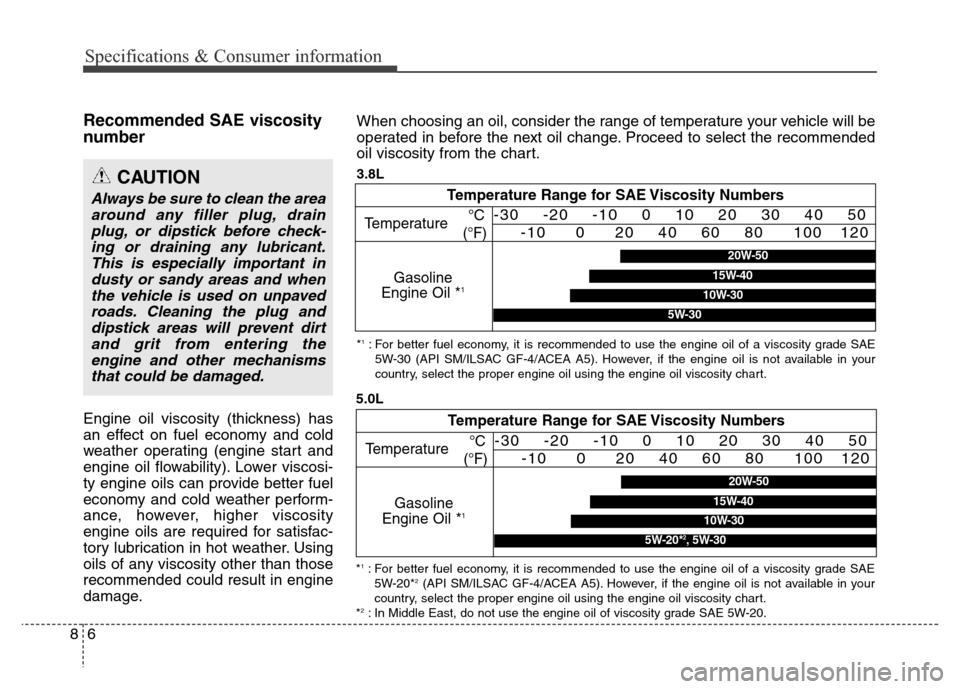Page 461 of 479

Maintenance
76 7
Waxing
Wax the vehicle when water will no
longer bead on the paint.
Always wash and dry the vehicle
before waxing. Use a good quality
liquid or paste wax, and follow the
manufacturer’s instructions. Wax all
metal trim to protect it and to main-
tain its luster.
Removing oil, tar, and similar materi-
als with a spot remover will usually
strip the wax from the finish. Be sure
to re-wax these areas even if the rest
of the vehicle does not yet need wax-
ing.CAUTION
• Wiping dust or dirt off the
body with a dry cloth will
scratch the finish.
• Do not use steel wool, abra-
sive cleaners, or strong deter-
gents containing highly alka-
line or caustic agents on
chrome-plated or anodized
aluminum parts. This may
result in damage to the pro-
tective coating and cause dis-
coloration or paint deteriora-
tion.
CAUTION
• Water washing in the engine
compartment including high
pressure water washing may
cause the failure of electrical
circuits or engine and related
part located in the engine
compartment.
• Never allow water or other liq-
uids to come in contact with
electrical/electronic compo-
nents and air duct inside the
vehicle as this may damage
them.
OJB037800
Page 475 of 479

85
Specifications & Consumer information
RECOMMENDED LUBRICANTS AND CAPACITIES
Lubricant Volume Classification
Engine oil *1*2
(drain and refill)
Recommends3.8L5.7l (6.02 US qt.)
API Service SM *3,
ILSAC GF-4 or above,
ACEA A5
5.0L7.2 l (7.61 US qt.)
Engine oil consumptionNormal driving conditionMAX. 1l /1500 km
-
Severe driving conditionMAX. 1l /1000 km
-
Automatic transmission fluid10.1l (10.67 US qt.)GS ATF SP-IV-RR,
HYUNDAI genuine ATF SP-IV-RR
Power steering0.9l (0.95 US qt.)
Pentosin CHF 202
Coolant3.8L10.1l (10.67 US qt.)Mixture of antifreeze and water
(Ethylene glycol base coolant for aluminum
radiator)
5.0L12.1l (12.79 US qt.)
Brake fluid0.7~0.8l
(0.7~0.8 US qt.)SAE J1703, FMVSS116 DOT-3 or DOT-4
Rear differential oil1.4l (1.48 US qt.)Hypoid gear oil API GL-5, SAE 75W/90
(SHELL SPIRAX X Equivalent)
Fuel77l (20.34 US gal.)
Refer to “Fuel requirements” in section 1
To help achieve proper engine and powertrain performance and durability, use only lubricants of the proper quality.
The correct lubricants also help promote engine efficiency that results in improved fuel economy.
These lubricants and fluids are recommended for use in your vehicle.
*1: Refer to the recommended SAE viscosity numbers on the next page.
*2: Engine oils labeled Energy Conserving Oil are now available. Along with other additional benefits, they contribute to fuel economy by reducing
the amount of fuel necessary to overcome engine friction. Often, these improvements are difficult to measure in everyday driving, but in a year’s
time, they can offer significant cost and energy savings.
*
3: If the API service SM or ACEA A5 engine oil is not available in your country, you are able to use API service SL or ACEA A3.
Page 476 of 479

Specifications & Consumer information
6 8
Recommended SAE viscosity
number
Engine oil viscosity (thickness) has
an effect on fuel economy and cold
weather operating (engine start and
engine oil flowability). Lower viscosi-
ty engine oils can provide better fuel
economy and cold weather perform-
ance, however, higher viscosity
engine oils are required for satisfac-
tory lubrication in hot weather. Using
oils of any viscosity other than those
recommended could result in engine
damage.
CAUTION
Always be sure to clean the area
around any filler plug, drain
plug, or dipstick before check-
ing or draining any lubricant.
This is especially important in
dusty or sandy areas and when
the vehicle is used on unpaved
roads. Cleaning the plug and
dipstick areas will prevent dirt
and grit from entering the
engine and other mechanisms
that could be damaged.
When choosing an oil, consider the range of temperature your vehicle will be
operated in before the next oil change. Proceed to select the recommended
oil viscosity from the chart.
Temperature Range for SAE Viscosity Numbers
Temperature
Gasoline
Engine Oil *
1
°C
(°F)-30 -20 -10 0 10 20 30 40 50
-10 0 20 40 60 80 100 120
*1: For better fuel economy, it is recommended to use the engine oil of a viscosity grade SAE
5W-30 (API SM/ILSAC GF-4/ACEA A5). However, if the engine oil is not available in your
country, select the proper engine oil using the engine oil viscosity chart.
20W-50
10W-30
15W-40
5W-20*2, 5W-30
Temperature Range for SAE Viscosity Numbers
Temperature
Gasoline
Engine Oil *
1
°C
(°F)-30 -20 -10 0 10 20 30 40 50
-10 0 20 40 60 80 100 120
20W-50
10W-30
15W-40
5W-30
5.0L3.8L
*1: For better fuel economy, it is recommended to use the engine oil of a viscosity grade SAE
5W-20*2(API SM/ILSAC GF-4/ACEA A5). However, if the engine oil is not available in your
country, select the proper engine oil using the engine oil viscosity chart.
*
2: In Middle East, do not use the engine oil of viscosity grade SAE 5W-20.
Page 478 of 479
Specifications & Consumer information
8 8
The tires supplied on your new vehi-
cle are chosen to provide the best
performance for normal driving.
The tire label located on the driver's
side center pillar gives the tire pres-
sures recommended for your car.
The engine number is stamped on
the engine block as shown in the
drawing.A compressor label informs you the
type of compressor your vehicle is
equipped with such as model, suppli-
er part number, production number,
refrigerant (1) and refrigerant oil (2).
TIRE SPECIFICATION AND
PRESSURE LABEL
OBH088004N
ENGINE NUMBER
OBH081003
OBH081010
■3.8L
■5.0L
OHC081001
AIR CONDITIONER
COMPRESSOR LABEL